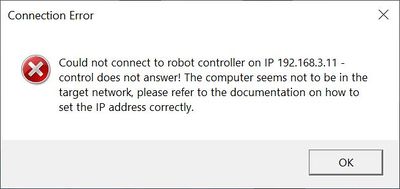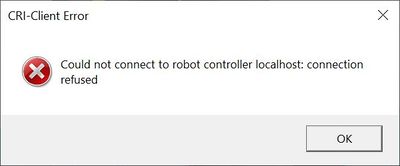Troubleshooting Connection Issues
This article explains how to troubleshoot common issues when connecting CPRog/iRC to a robot.
If your robot got an embedded control and therefore uses an Ethernet connection read the chapter Ethernet. If it connects via a USB-to-CAN adapter read chapter CAN.
Ethernet
If connecting fails CPRog/iRC will show an reason and sometimes an explanation. Since version 14 this explanation contains advice on how to solve the most common causes.
Read the following sections to identify and fix the issue.
Make sure the robot is powered on
Depending on the type of robot you should see one or more lights in the control cabinet or at the base of the robot.
The robot needs ca. 30-60s to start up. If your robot has a control cabinet the green LEDs at the axis and IO modules start flashing when it is ready. If the lights do not start flashing or stop flashing during operation (except when reading/writing firmware parameters) the embedded robot control software is not running. Try restarting the robot. If that does not help try installing the newest update. This can also fix corrupt configurations that prevent connecting.
Check the Ethernet cable
Make sure the network (ethernet) cable is well plugged in at both the robot and the PC. Some laptops have a loose ethernet socket that can lead to bad connections or the plug falling out of the socket.
To rule out any issues with the network infrastructure try connecting with a direct cable between PC and robot.
One such issue is an address conflict. This means a different device on the network uses the same IP address as the robot. In this case CPRog/iRC may or may not be able to connect or loose connection during operation.
Try different cables. Some low quality cables may work with one PC but not with another.
Check the network configuration of your PC
In order to connect to the robot the network interface of your PC must be configured to use a static IP address in the same network as the robot. Since the standard IP of the robot is 192.168.3.11 we recommend 192.168.3.100 (the last number of the address can be any number in the range 1-254 except 11).
To configure a static IP address read this guide and enter the following values:
- IP address: 192.168.3.100
- Subnet mask: 255.255.255.0
- Default gateway: leave empty or enter 192.168.3.1
- Do not change the DNS server settings
If you change the IP address of the robot you will need to adapt the settings above for the new address. If you are connecting to the robot via WiFi your network interface should configure itself automatically.
Use ping to test the network
Ping is a basic tool for testing network connections. You give it an IP address and it will check whether your PC can reach it via the network (note: ping may be blocked in some company networks, try using a direct network cable).
Open a command line and type ping 192.168.3.11. Ping will try 4 times, this will take a couple seconds. Single failures are okay, if all 4 fail you likely got a network issue, e.g. wrong configuration, defective cable, etc.
Error messages from CPRog/iRC
CPRog/iRC does some tests to help you identify the issue. You may see the following messages:
V13
CPRog/iRC V13 differentiates two types of connection issues:
This error happens if the IP address of your PC is not configured correctly:
The connection refused error happens if the robot is reachable but does not respond. This may occur if there is an address conflict or if the robot control software is not running. See the sections above for explanations.
V14
Invalid address or unable to resolve hostname.
Make sure you entered a valid IP address or hostname. If you entered a hostname check whether your PC is connected to the network.
The robot seems to be in a different subnet than the PC.
Please check the network configuration of your PC and set a static IP address in the same network as the robot. Also make sure that the robot is powered on and connected to the same network.
Could not ping the robot control.
Make sure that the robot is powered on and connected to the same network as the PC.
Could connect to the robot control computer but the control software did not to respond.
Try restarting the robot control or update to the most recent version. Contact support if this issue persists.
Could ping the address but not connect via CRI or SSH.
This usually means that the given IP address is assigned to a different device. Try connecting via a direct network cable and consider assigning unique IP addresses.
CAN
- Make sure that the CAN adapter is plugged in, the wiring is correct and the robot is powered on.
- Make sure the CAN adapter is recognized by your computer and that it uses the correct driver.

